Dezeen School Shows: a rocking chair inspired by water lilies is included in Dezeen’s latest school show by students at University of Gothenburg.
Also included is a project exploring the potential of horse hair for net making, and furniture made using woodcut printing blocks.
Institution: University of Gothenburg
School: HDK-Valand Campus Steneby
Courses:
Tutors: Daniel Winterbottom, Luka Jelusic, Erika Henriksson, Eva-Johanna Isestig, Mate Rupic, Bennett Song, Joseph Weiss, Torsten Hild, Heiner Zimmermann, Tobias Birgersson, Karin Peterson, Maria Sjöstrand and Jenny Stentoft
School statement:
Campus Steneby is a unique environment for education and research in craft and design at Gothenburg University. Nestled among the lakes and forests of Dalsland midway between Gothenburg and Oslo – we are an international community of makers, artists and designers who are attracted by our philosophy of education that involves total immersion in the workshop experience.
We offer bachelor educations in Metal Art and Wood Oriented Furniture Design. This year we are launching a new education called Crafting Futures which sits at the intersection of design, craft and fine art. We also offer an MFA in Applied Art and Design.”
Floating City by students on participatory design and build summer courses
Floating city is the third in a series of design build projects in Dals Långed, where architecture, landscape architecture and design students collaborate with the local population to create public meeting places.
“The long-term idea of Floating city is to become a venue for different cultural events, to cover a wide range of target audiences and also a range of preferences when it comes to active versus passive participation.
“The first stage of project during summer 2024 was to design and construct a usable prototype of a modular floating structure as a test arena, experimental in nature, as it explores what such a platform could mean and how it could function in a long-term perspective.
“Over the course of four weeks, several floating prototypes were built and small public events were organised to test and evaluate the proposed solutions.
“Floating city builds, among other things, on a democratic and socially inclusive process that makes use of local creativity, power and competence.
“After the completion of the prototype, numerous community stakeholders expressed a wish for the platforms to become permanent: from students and tourist erecting tents for overnight stays to cultural organisations hoping to arrange festivals and other cultural activities on water.”
Students: Students on participatory design and build summer course students
Course: Participatory Design and Build Summer Course
Tutors: Daniel Winterbottom, Luka Jelusic, Erika Henriksson and Mate Rupic
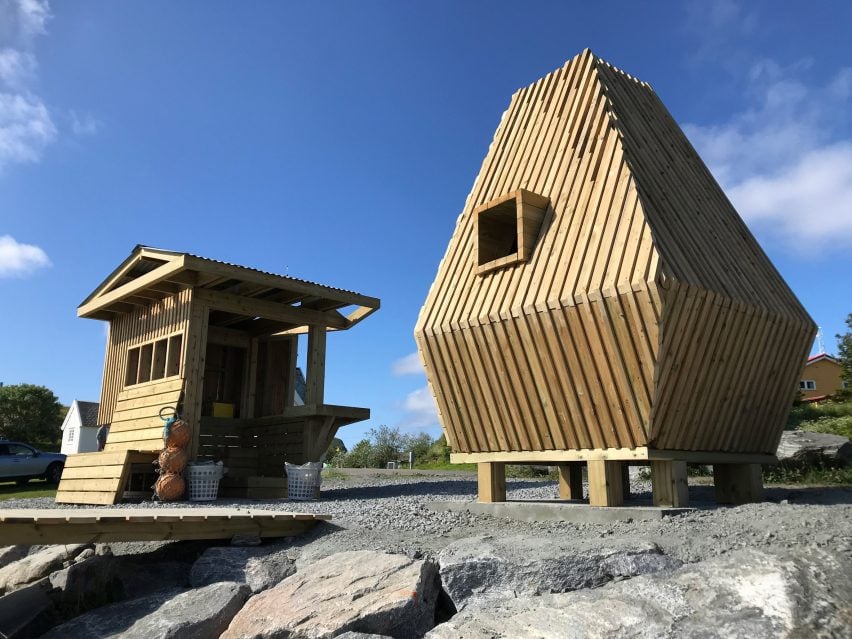
Participatory Design and Build in Traena by students on participatory design and build summer courses
“Traena is a group of island in Helgeland region of Norway. Situated at the edge of Arctic circle, the community managed to stay proactive in keeping its members on the island despite the challenges of depopulation.
“HDK-Valand Steneby together with Department of Landscape Architecture at University of Washington established a collaboration with Traena Kommune and during summers 2022 and 2023 two groups of students from USA and Sweden realised two projects with inhabitants of Traena.
“The island provides elementary school education, whereas for highschool, children move to mainland. It was deemed important by community elders to develop a strong sense of belonging in children, hoping that they will move back to the island after completing their education.
“The assigned location was the beach in the centre of village, which is also the first sight for anyone arriving to the island.
“The participatory process with a local youth club resulted in decision to build two structures at the edge of the beach, a large floating raft with a firepit and a small terrace for more in-mate gatherings in the corner of the beach.”
Students: Students on participatory design and build summer courses
Course: Participatory Design and Build Summer Course
Tutors: Daniel Winterbottom, Luka Jelusic, Eva-Johanna Isestig, Mate Rupic, Bennett Song and Joseph Weiss
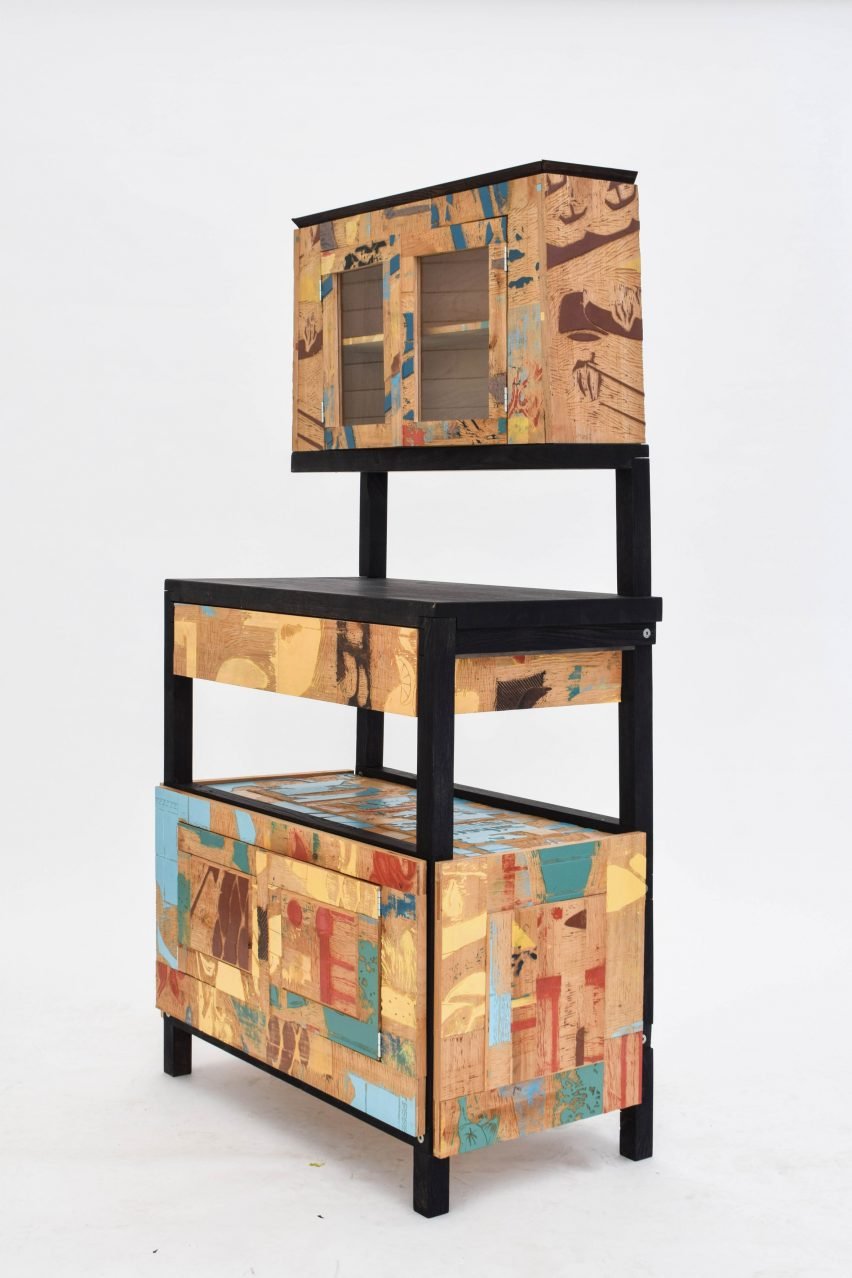
Xylographic Furniture by Leo Palmer
“The objects we value most are those that tell a story.
“By examining the role of craft and ornament in furniture design I developed a unique approach that aims to heighten an objects narrative quality.
“The process developed during this project, uses woodcut printing blocks and repurposes them as ornament.
“Rather than finding and using existing printing blocks, a new set is made for each piece of furniture. This means that a related woodcut print is created as a graphic byproduct.
“To further reinforce the narrative idea, the theme of the print itself reflects the object’s context or function.
“The result is a unique piece that can visually communicate, for example, a personal place, memory or activity. The physical expression of this, via the piece of furniture, induces an emotional attachment between it and its owner.”
Student: Leo Palmer
Course: MFA Applied Art and Design
Tutor: Torsten Hild
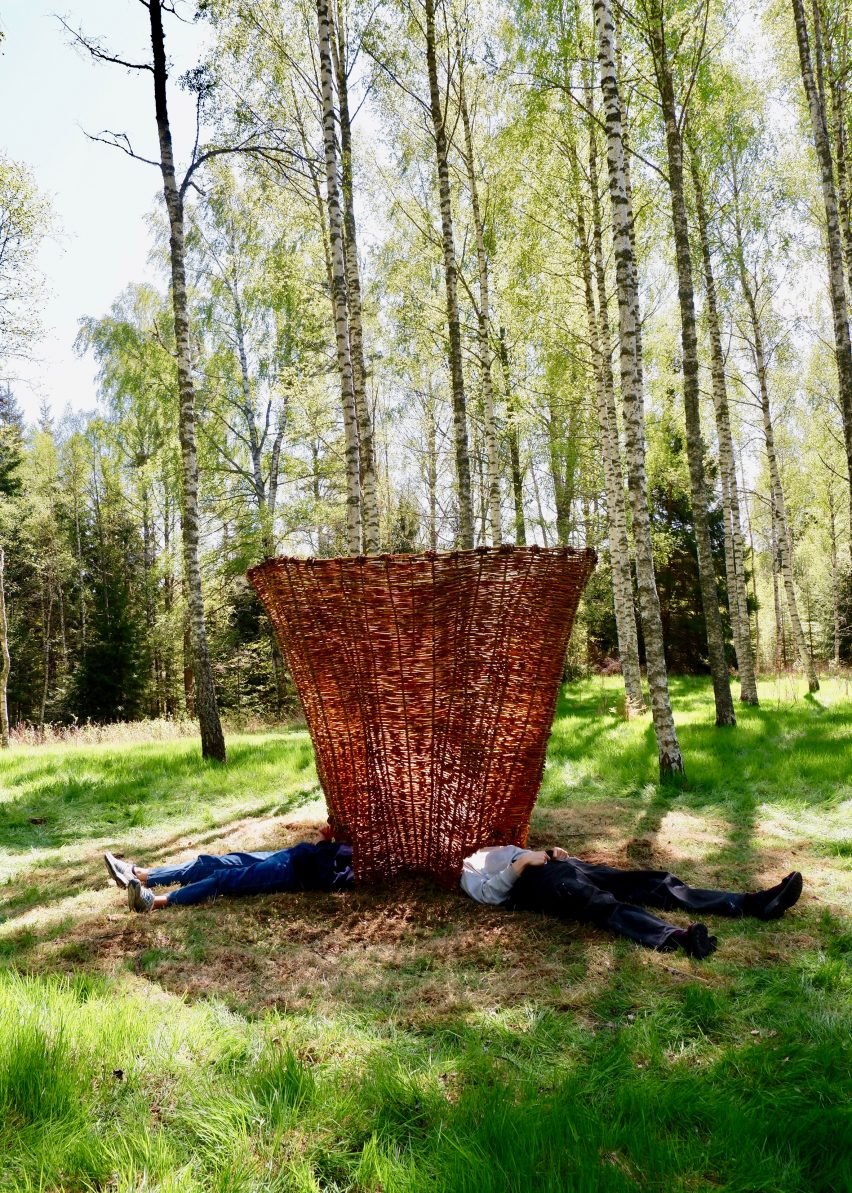
When I Am Among the Trees by Alice Kettle
“When I Am Among the Trees, is an exploration into the space between human and non-human centred perspectives.
“A large woven space from willow (known as the Sun Egg) that invites interaction, fascination and restoration, as a way of helping us to reorientate our thinking to one of co-existence and collaboration.
“Questioning if the simplicity of inviting adults to take time to be more childlike, playful and curious, could encourage us to take time to understand the relations between living things in changing ecologies.”
Student: Alice Kettle
Course: MFA Applied Art and Design
Tutor: Torsten Hild
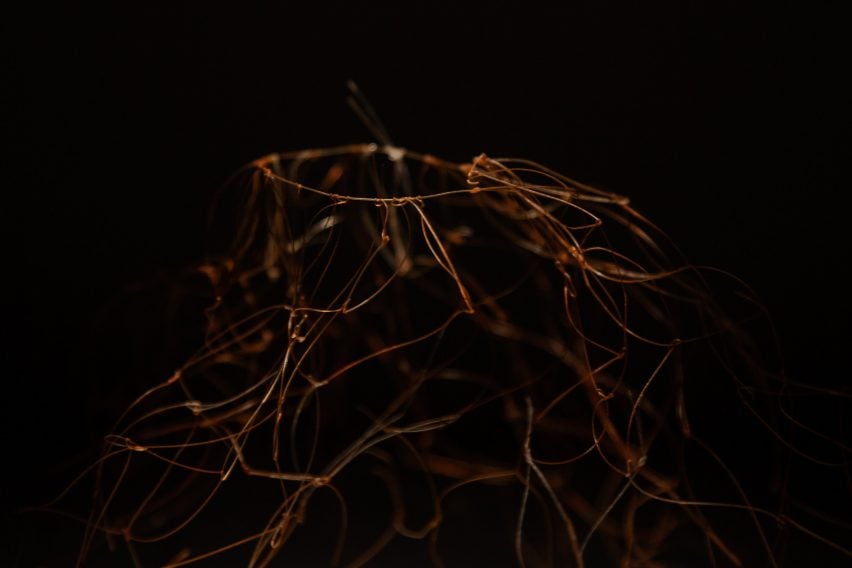
Nätverk by Josefine Lundgren
“Tender knots and delicate lines. A meeting between horsehair and net making, investigating the relationship and interdependence of material and technique. An exploration of visual tactility, intrinsic properties of a material and fundamental constructions.
“The project consists in spirally constructed net structures whose expressions are allowed to depend on the information they receive from the tools, the material variations and my hands. The approach creates a textile material and a shape that appear simultaneously. Every new net is based on the knowledge obtained from previous nets.
“By sourcing horse hair locally I gained a heterogeneous material regarding shade, shape and thickness. Through net making I investigate the individuality of the horse hair in its raw state, its properties and will, how every single hair influences the next hair. During the process I experience up close the willfulness, how no knots look the same and the colour changes as the net grows.
“In the meeting between material and technique, the net loses its ability to serve as a net, losing its primordial function. The horse hair which originally acts as a thick and dense tail turns into separated monofilaments, composed in a new manner with each individual character visible. The heterogeneity becomes a language within the form. What was perceived as strong and durable suddenly becomes fragile.”
Student: Josefine Lundgren
Course: BFA Textile-Body-Space
Tutors: Karin Peterson, Maria Sjöstrand and Jenny Stentoft
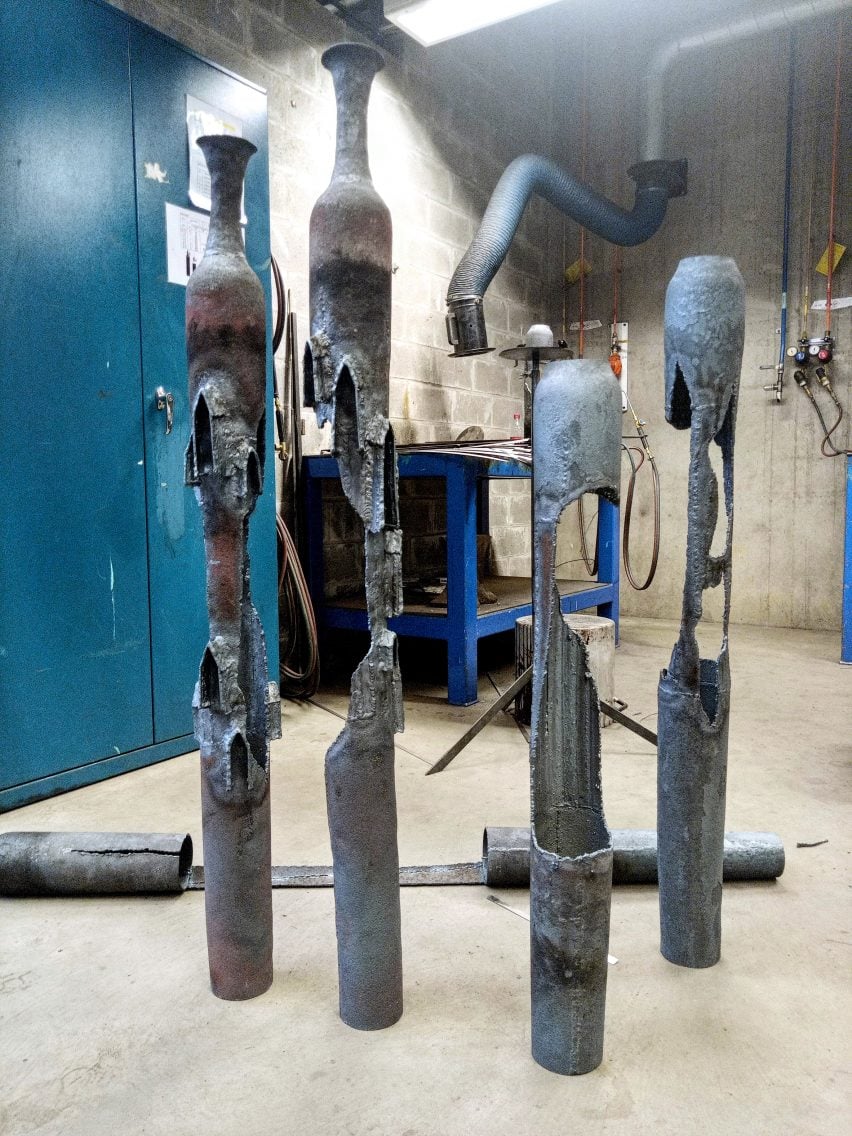
Weird.Strange.Abnormal by Miriam Ståhlgren
“Weird.Strange.Abnormal uses the forged vessel as a canvas to tell a story about independence, dependence, the small tribe or family and the longing for a frontier away from the core of an overbearing society.
“Each vessel forms a separate island, each with a little settlement hiding away where the broken shape allows it.
“Together, the vessels form an archipelago of small societies that are both together and apart.
“The vessels are partially forged and partially welded into shape and then painted with a light layer of oil paint to both enhance the qualities of the forged steel and to protect it.”
Student: Miriam Ståhlgren
Course: BFA Metal Art
Email: miriam.stahlgren[at]gmail.com
Tutors: Heiner Zimmermann and Tobias Birgersson
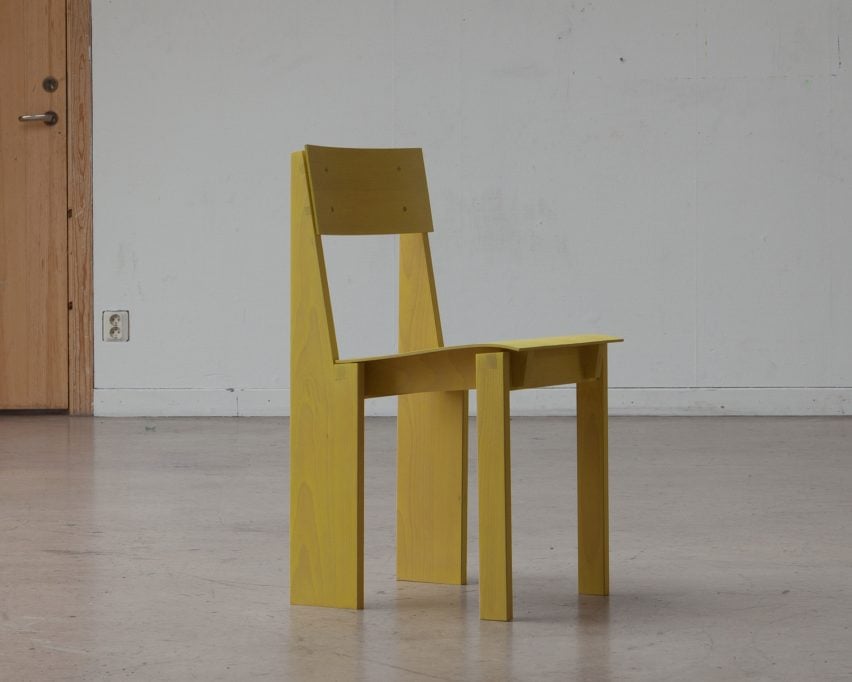
Furniture inhabiting space: Between dream and reality – things (in)visibly present by Hannes Blixt
“In the project Furniture inhabiting space, the question is posed: how is a chair?
By sketching directly in the material, full-scale prototypes are made, where construction, dimension and arrangement come into expression in the furniture.
“This approach allows for an organic way of giving form, while being responsive to its spatial influence.
“The result is a chair that conveys a form-language within both the tectonic and the perceptual.”
Student: Hannes Blixt
Course: MFA Applied Art and Design
Tutors: Torsten Hild
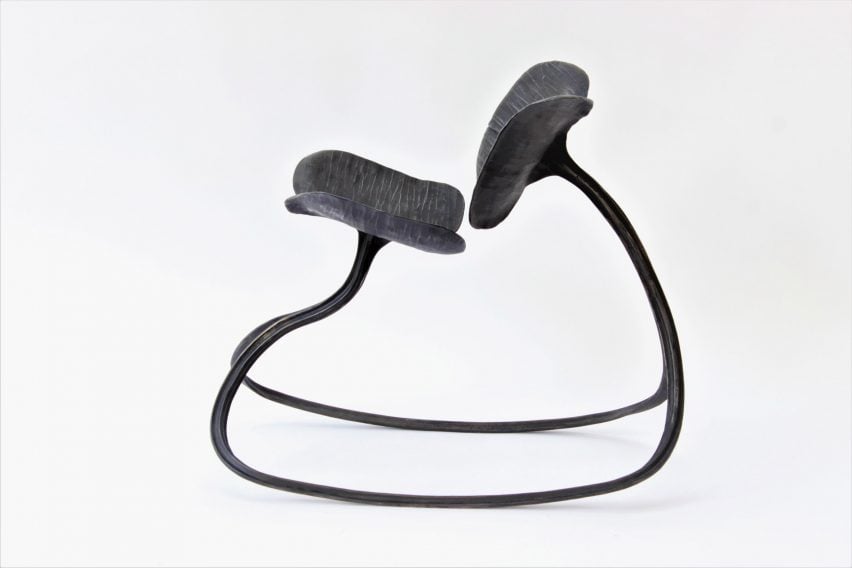
Water Lily Chair by Jean-Baptiste Galon
“A chair to swing like frog. Jokes can sometimes give ideas.
“In my work I like to bring a positive character.
“So I created a family of chairs, ‘the water lily chairs’ about the nickname foreigners give to the French people, frogs.
“So like a good French frog I need to sit on my water lily to rest and swing.”
Student: Jean-Baptiste Galon
Course: BFA Metal Art
Email: galonjb[at]hotmail.fr
Tutors: Heiner Zimmermann and Tobias Birgersson
Partnership content
This school show is a partnership between Dezeen and University of Gothenburg. Find out more about Dezeen partnership content here.

